|
 Several
years ago I had an interesting job. For two weeks I would
hike to some isolated pinyon or juniper at the base of Dead
Horse Point. I would pack my spotting scope, binoculars and
notebook to these spots, settle in and watch. I had a perfect
view of Tom Cruise, or his stunt double Ron Kauk, rapelling
down the sheer Wingate sandstone face to their predetermined
mark. From there they would ascend, hand-jamming the wider
cracks, face climbing where the cracks dissolved. Circling
overhead was the Mother Ship, the helicopter with a nose-mounted
camera and an operator inside using a video screen and joy
stick to operate the camera. I’d make entries into my
notebook on how the local band of desert bighorn sheep responded
to the presence of the helicopter. It was a tough job and
yes, someone did have to do it. Fortunately, that someone
was me, though I almost got fired. Several
years ago I had an interesting job. For two weeks I would
hike to some isolated pinyon or juniper at the base of Dead
Horse Point. I would pack my spotting scope, binoculars and
notebook to these spots, settle in and watch. I had a perfect
view of Tom Cruise, or his stunt double Ron Kauk, rapelling
down the sheer Wingate sandstone face to their predetermined
mark. From there they would ascend, hand-jamming the wider
cracks, face climbing where the cracks dissolved. Circling
overhead was the Mother Ship, the helicopter with a nose-mounted
camera and an operator inside using a video screen and joy
stick to operate the camera. I’d make entries into my
notebook on how the local band of desert bighorn sheep responded
to the presence of the helicopter. It was a tough job and
yes, someone did have to do it. Fortunately, that someone
was me, though I almost got fired.
 Not because of some conflict of interest - the production
company was paying my salary but I did have the authority
to restrict their filming. No, the problem stemmed from an
offhand comment that I made to one of the Assistant Directors.
I stated that the women of Moab considered Tom to be “just
a 9" because his climbing moves were not that smooth.
From then on, I was banished to my outpost.
Not because of some conflict of interest - the production
company was paying my salary but I did have the authority
to restrict their filming. No, the problem stemmed from an
offhand comment that I made to one of the Assistant Directors.
I stated that the women of Moab considered Tom to be “just
a 9" because his climbing moves were not that smooth.
From then on, I was banished to my outpost.
Which was fine. Not only did I have a great vantage point
to watch the movie filming from below, but I also was able
to locate several different groups of bighorn sheep. I would
watch their reactions, or lack thereof, to the helicopter,
as well as observe foraging behavior and group dynamics. As
part of the contract I returned to the area a few days after
filming to relocate sheep and search for hats blown over the
edge.
 I
did relocate the two bands of ewes and lambs that I had been
observing, but could not find an older ram that I watched
for several days. His disappearance in that rugged land didn’t
indicate that the filming activity had impacted his behavior.
He could have been up a different side canyon or higher up
on the talus slopes out of view. Of course, he could have
been canyons away; there were plenty of fresh sheep tracks
and scat all over the area. I
did relocate the two bands of ewes and lambs that I had been
observing, but could not find an older ram that I watched
for several days. His disappearance in that rugged land didn’t
indicate that the filming activity had impacted his behavior.
He could have been up a different side canyon or higher up
on the talus slopes out of view. Of course, he could have
been canyons away; there were plenty of fresh sheep tracks
and scat all over the area.
Biologists speculate that at one time desert bighorns were
abundant in southern Utah. Carved or painted images adorn
many a canyon canvas, and their remains have been unearthed
in many archaeological sites. Beyond just a source of meat,
their bones and horns were used as tools by the Native Americans.
Before settlers arrived in the West, population estimates
ranged between 500,000 and one million wild sheep roaming
North America.
 Diseases
spread by domestic livestock, over hunting, and habitat encroachment
impacted those populations. When Canyonlands National Park
was established in 1964, the park’s herd was an estimated
75-100 desert bighorn. The health of the herds within the
different districts varied, and there was some interaction
with herds located outside of the park’s boundaries.
Through allocation of the domestic livestock grazing privileges
to wildlife, grazing buffers established between livestock
and bighorn herds, a park-wide ban on hunting, and dramatic
reductions in habitat alteration, the area’s herd increased
five to sixfold. From this larger population base, small groups
of sheep have been trapped and relocated to other areas, like
Arches or Capitol Reef National Parks. Monitoring of these
“seed herds” will determine if the fruits of these
relocation labors pay off. Diseases
spread by domestic livestock, over hunting, and habitat encroachment
impacted those populations. When Canyonlands National Park
was established in 1964, the park’s herd was an estimated
75-100 desert bighorn. The health of the herds within the
different districts varied, and there was some interaction
with herds located outside of the park’s boundaries.
Through allocation of the domestic livestock grazing privileges
to wildlife, grazing buffers established between livestock
and bighorn herds, a park-wide ban on hunting, and dramatic
reductions in habitat alteration, the area’s herd increased
five to sixfold. From this larger population base, small groups
of sheep have been trapped and relocated to other areas, like
Arches or Capitol Reef National Parks. Monitoring of these
“seed herds” will determine if the fruits of these
relocation labors pay off.
Some population gains have been offset by losses due to disease,
increased recreational activity and habitat alteration that
may be associated with prolonged drought. But if you are out
to see bighorn sheep, November is an excellent month to observe
congregations of animals going through the annual mating season
or rut. And you don’t have to hide out beneath some
scraggy juniper to watch these preoccupied bighorns put on
a show.
The annual Desert
Bighorn Sheep Festival will take place November 14th and 15th
in Moab. A Friday night lecture at the Moab Information Center
starts at 7:00 p.m. and will be given by biologists from the
Utah Division of Wildlife Resources. On Saturday there will
be a field trip for those interested in viewing this majestic
species.

|


 Not because of some conflict of interest - the production
company was paying my salary but I did have the authority
to restrict their filming. No, the problem stemmed from an
offhand comment that I made to one of the Assistant Directors.
I stated that the women of Moab considered Tom to be “just
a 9" because his climbing moves were not that smooth.
From then on, I was banished to my outpost.
Not because of some conflict of interest - the production
company was paying my salary but I did have the authority
to restrict their filming. No, the problem stemmed from an
offhand comment that I made to one of the Assistant Directors.
I stated that the women of Moab considered Tom to be “just
a 9" because his climbing moves were not that smooth.
From then on, I was banished to my outpost. I
did relocate the two bands of ewes and lambs that I had been
observing, but could not find an older ram that I watched
for several days. His disappearance in that rugged land didn’t
indicate that the filming activity had impacted his behavior.
He could have been up a different side canyon or higher up
on the talus slopes out of view. Of course, he could have
been canyons away; there were plenty of fresh sheep tracks
and scat all over the area.
I
did relocate the two bands of ewes and lambs that I had been
observing, but could not find an older ram that I watched
for several days. His disappearance in that rugged land didn’t
indicate that the filming activity had impacted his behavior.
He could have been up a different side canyon or higher up
on the talus slopes out of view. Of course, he could have
been canyons away; there were plenty of fresh sheep tracks
and scat all over the area. Diseases
spread by domestic livestock, over hunting, and habitat encroachment
impacted those populations. When Canyonlands National Park
was established in 1964, the park’s herd was an estimated
75-100 desert bighorn. The health of the herds within the
different districts varied, and there was some interaction
with herds located outside of the park’s boundaries.
Through allocation of the domestic livestock grazing privileges
to wildlife, grazing buffers established between livestock
and bighorn herds, a park-wide ban on hunting, and dramatic
reductions in habitat alteration, the area’s herd increased
five to sixfold. From this larger population base, small groups
of sheep have been trapped and relocated to other areas, like
Arches or Capitol Reef National Parks. Monitoring of these
“seed herds” will determine if the fruits of these
relocation labors pay off.
Diseases
spread by domestic livestock, over hunting, and habitat encroachment
impacted those populations. When Canyonlands National Park
was established in 1964, the park’s herd was an estimated
75-100 desert bighorn. The health of the herds within the
different districts varied, and there was some interaction
with herds located outside of the park’s boundaries.
Through allocation of the domestic livestock grazing privileges
to wildlife, grazing buffers established between livestock
and bighorn herds, a park-wide ban on hunting, and dramatic
reductions in habitat alteration, the area’s herd increased
five to sixfold. From this larger population base, small groups
of sheep have been trapped and relocated to other areas, like
Arches or Capitol Reef National Parks. Monitoring of these
“seed herds” will determine if the fruits of these
relocation labors pay off.